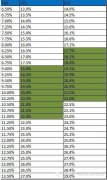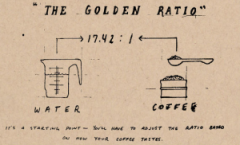The source of coffee, the method of making and blending coffee, and matters needing attention.
(i) Introduction to Coffee
1 Origin of Coffee
Coffee originated in Ethiopia in Africa, and there are many stories about its discovery. One of the legends accepted by most people is that about 3000 years ago, a shepherd saw his sheep eating the fruit of an unknown bush, excited, excited, and jumping. Therefore, the shepherd also tasted the fruit himself and felt the same spirit. Because of Islam, believers are forbidden to drink alcohol, so people replace alcohol with coffee and spread it quickly.
2. Origin of coffee
At present, coffee production in the world is mainly concentrated in the following countries and regions: Brazil, Indonesia, Colombia, Jamaica, Ecuador, New Guinea and other countries, among which Brazil is the most famous. Coffee was introduced into Taiwan in the second half of the 19th century, and then introduced into Hainan. Now Yunnan, Guangdong, Guangxi, Fujian and other places in China are planted, especially Yunnan's small coffee quality is better, comparable to the world's famous coffee.
3. Composition of coffee
Coffee contains caffeine and volatile aromatic oil, raw coffee and roasted coffee beans in composition, although there are different, but all contain protein 5%-8%, fat 10%-14%, caffeine 1.2-1.8% and inorganic salts, carbohydrates, water, fiber, multivitamins, fat, sugar and aromatic oil.
4, the efficacy of coffee
Coffee beverages are beverages made with coffee bean extracts. Coffee has high nutritional value, moderate drinking has the effect of helping digestion, invigorating spirit, quenching thirst, eliminating fatigue, etc., widely loved by people, especially Europeans and Americans, as an essential part of daily life.
(ii) Production of coffee
1. Coffee roasting
Roasting is an important process in coffee making. Roasting is to fry coffee beans, but the time should not be too long, on the degree of roasting in terms of light roasting, cinnamon roasting and strong roasting three kinds. Roasted coffee beans dissolve the aromatic oil in water and emit aroma, but some of the aroma evaporates. More popular is a method of roasting coffee beans quickly over charcoal, which keeps the aroma of coffee essentially intact.
2, coffee crushing and mixing
Roasted coffee beans after grinding aroma, the best situation is to grind coffee beans before each drink, so that the flavor is better. Generally speaking, after grinding for fine particles of coffee taste strong, after grinding for coarse particles of coffee taste aromatic. In order to make the brewed coffee strong and fragrant, you can mix the fine coffee powder and drink it.
3. Coffee brewing
In restaurants or coffee shops, the common coffee brewing methods are distilled brewing method and electric coffee pot brewing method.
(1)Distillation brewing method
Distillation brewing method to boil coffee not only retains the original delicious aroma of coffee taste, people can also clearly see from the transparent glass pot brewing coffee process. When brewing coffee, coffee powder is installed in the upper pot, water is installed in the lower pot, alcohol lamp or gas is used to heat the lower pot, after the water is boiled, all the water in the lower pot rises to the upper pot, the fire source is reduced, the coffee powder is gently stirred, and then the fire source is removed. When the coffee in the upper pot gradually flows into the lower pot, it can be poured into a cup to drink.
(2)Electric coffee pot brewing
Coffee beans are ground in a grinder, then iced water is added to the water tank in the electric coffee pot, and after the lid is closed, electricity is applied, that is, the process of automatic brewing, filtering and dripping into the pot below begins.
Other factors affecting coffee brewing
1, water quality: and tea, brewing coffee must pay attention to water quality, can not use water containing a lot of iron, can not use a lot of alkaline hard water, the most ideal water should be distilled water. In addition, there are certain requirements for the water temperature, the water temperature should be between 80 ° C--90 ° C, can not use boiling water, otherwise it will increase the bitterness of coffee, reduce the quality of coffee.
2. Soaking time
Because coffee contains caffeine and aromatic oil, so the soaking time should not be too long, usually about 2 minutes can be soaked, too long a time of soaking not only destroyed the flavor of coffee, but also will make coffee liquid float, make coffee turbid.
3. Vessels
Glassware and crockery are the best ways to make coffee. If metal utensils are used, they will cause oxidation reactions, giving coffee an unpleasant taste.
4. Dosage
The amount of coffee used depends on the size of the coffee particles brewed and the preferences of the coffee drinker. Fine-grained coffee is usually less than fine-grained coffee, while coarse-grained coffee is about 15% more than fine-grained coffee. If you brew 40 - 50 cups of coffee with 500 grams of coffee, it is espresso.
(4), coffee service should be noted
1, choose high-quality coffee and do not store a lot, otherwise it will affect the quality and aroma of coffee.
2, according to the thickness of coffee particles to determine the corresponding brewing time.
3, choose high-quality water, and the ratio of water and coffee should be appropriate. Usually 100 grams of water is added to every 10 grams of coffee.
4, coffee is best to boil and drink, otherwise it will affect the taste of coffee, but also make coffee lose aroma.
5, carefully clean the coffee brewing equipment, otherwise it will produce odor.
6, the quality of cream will also affect the quality of coffee, the better the cream and coffee flavor fusion.
Important Notice :
前街咖啡 FrontStreet Coffee has moved to new addredd:
FrontStreet Coffee Address: 315,Donghua East Road,GuangZhou
Tel:020 38364473
- Prev

Effect of Powder content on Coffee in Coffee production
1. The concentration determines the richness of the coffee. It is the soluble matter that determines the concentration. (it is worth mentioning that XLW007 in the common sense group mentioned that insoluble substances can also increase the thickness of caffeine. I totally agree, but this time I only focus on the main cause of soluble matter.) generally, the calculation can be measured by the concentration photorefractometer: TDS%= TDS/Coffee Weight.
- Next

Calculation of the ratio of Gold Powder to Water in Coffee extraction
In the study of cup measurement or extraction of freshly baked coffee, barista flexibly changes different powder-to-water ratio and baking forms according to different coffee bean characteristics, mainly in order to restore or preserve the original natural flavor and characteristics of coffee. In the manual extraction skill teaching class, artificial preferred quality products, coupled with the quality of fresh baking, promote coffee.
Related
- What is the meaning of lactic acid fermentation with coffee bean treatment?
- How to judge the state of foam by sound?
- How does the latte pull out the unicorn pattern? Come to get for a little trick to improve the flower pull!
- Will flower pulling affect the taste of the latte?
- Do you know the history of coffee?
- The difference between honey treatment and sun washing what is raisin honey treatment?
- What kind of milk can a novice use to make coffee foam to keep the foam longer? The correct method and skills of milking tutorial sharing
- Why do washed coffee beans taste sour? Flavor characteristics of washed Coffee
- Introduction to the skill of how to practice the size and height of water injection around the circle of hand-brewed coffee
- How do beginners practice coffee flower drawing from scratch?

